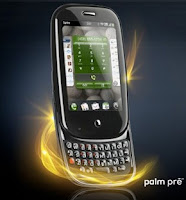 ...or, "holy #$@%, I'm actually EXCITED about an upcoming Palm device??"
...or, "holy #$@%, I'm actually EXCITED about an upcoming Palm device??"Most of my friends know that I currently prefer Windows Mobile devices for their balance of power and features. What most of them don't realize is that I always felt that I'd switch in a heartbeat if something better came out... but sadly that hasn't happened yet.
Android is still missing some features I use on a regular basis, iPhone's OSx is far too limiting and crippled... Symbian comes close, and has a pretty competitive feature set, however arguably not any better than Windows Mobile. Blackberry shouldn't even be considered a Smartphone to begin with (its a messaging device, not the same thing).
But never in a million years did I think I would ever consider Palm to possibly be my next Smartphone OS.
Most of us gadget junkies got started on Palm Pilots back in the day, but they've been something of a joke for the last few generations of handsets. Their extrememly limiting OS has had no major updates in a decade (note, I said MAJOR, not the little things they added here and there over the years- those don't count), which has caused many industry anylists to predict its demise.
But, as I mentioned earlier, Palm seems to have been secretly workin on something behind closed doors.
Apparently hiring top device and OS design gurus from competeing companies (such as Apple, for example), the project has been stirring up Treo fans all over the interweb.
As an enthusiast, I heard about the OS they were working on (Nova) and the device (Palm Castle), but never really gave it more than a glance and possibly a mention.
I was predicting Palm's efforts as too little too late.
Well, that all changed this CES.
I'm actually really impressed at what I'm seeing and reading.
I now regret any moment in which I dismissed this effort as "same old Palm". This is NOT same old Palm. In fact, forget everything you knew about Palm. This new company is like the Chuck-Norris-Ninja-Pirate of Palm, which makes everything Palm did until now pale in comparison.
Yes, this could really be what brings them back from the proverbial dead (or at least, proverbial "no-one-cares-what-you-release-anymore").
The OS, which is based on some sort of Web rendering engine, can be easily customized by anyone who knows basic web programming (html, xml, etc), not to mention appears to support some killer over-the-air sync services, A2DP, and advanced multitasking. Basically, all the things wrong with the old Palm OS and then some.

Then there's the hardware. Internally known as the Castle, the Palm Pre (pre? Pre-what?) seems to also have listened to everything people disliked about older Palms:
- No more cramped screen, display is now a majority of the device, while the KB slides out from underneath (a pet peeve of mine was a device as large as a Treo had a screen size barely larger than a standard phone).
- Standard mini-USB port (no propietary connector)
- 3.5mm standard stereo jack!! (about time)
- Sleek and thin device design (no more clunky Treo form factor)
Also, the hardware looks great, but there are a few top-of-the-line devices already out with higher specs in some areas. For example, the Omnia is pushing a killer 5mpixel camera, while this is still sporting only 3. The HTC Touch Pro also sports only 3mpixels, but it has a higher resolution screen (640x480). And both the Touch Pro and Omnia are available for a while already now, while this is not slated to release for a couple of months.
What does that mean? It means that when the Pre is finally available, these specs will be considered standard already and no longer high-end as the next wave of devices is announced.
What I could see happening, however, is that this will be offered at a mid-to-low tier price point, to compete directly with the G1 and iPhone 3G (under $200). If Palm manages to do that, we could have a winner here.
Things in the mobile space are about to get a lot more interesting...


